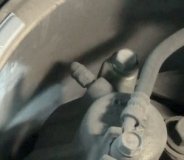Breaking loose steel brake lines and and hoses is sometimes a chore.
Breaking really rusty ones can go either way, breaking them loose/or just twisting the darn lines and maybe breaking them.
Mud grease/goo/and them having been sprayed with "Rhino Liner" or other bed linings really makes it a challenge.
You must clean this from the fittings just to be able to start the task.
To get to your fittings, A pressure washer/ purple power/chipping with a sharp screwdriver and a hammer might scale the stuff off. Carefully waving a propane torch over it may soften things up. (Let's not cook something that needs to stay, such as a hose). Along with that, insure you have no fuel leaks.
We do not want to heat the lines up real hot! Just get the crud off!
I do not recommend heating fittings to remove them from other fittings, cooking the fluid within is surely not a good idea.
Let's not use oil on the fittings either, it can get mixed in with the brake fluid and swell up (ruin) rubber stuff in the system, such as wheel cylinder cups and lot more stuff. Basically, your brakes could fail from ignorance!
We really like to have "pretty" fittings to deal with, not stripped and smeared nuts.
Regular wrenches should not be used on the "flare nut" (the one with the steel line through it!) You can use them on the brake hose and even the "blocks" they screw into.
A "flare nut wrench" should be used on the flare nut. As regular wrenches will strip the nuts.
A flare nut wrench will strip too.
I found a method that works really well just to break them loose. Then you can continue the normal way with the wrench.
The trick is to use vise grip pliers!
Not on the nut on the wrench
Sorry this took so long.
In my pictures below (which I had to download new drivers in my computer to read them, dang Grand youngins!) My computer guy had to figure out what had changed, good thing I fix his Jeep!
I could not find a pair of small "needle nose" vise grips for the pictures, They work the best in a tight spot. The original kind can work too.
Position the pliers so they don't "bottom out" we only have to break the threads loose. Less than a 1/4 turn. Then even a regular wrench should back them the rest of the way out.
When you are "pulling" the flare wrench, you need to be back-holding the other part with a wrench too. Basically, this equalizes the pressure and the goodies in-between the wrenches should not move around which might bend or break something on down the line.
Sometimes a quick love tap to the flare wrench with a hammer will break the bond of the threads.
So
Remember
Back hold
vise grips (regular or needle nose) will keep your flare nut wrenches from stretching and stripping and gripping really well!
Just have to break it loose, then you are home free!
Keep us posted,
The Medic
Images (Click to make bigger)
Sunday, October 1st, 2017 AT 7:22 PM





